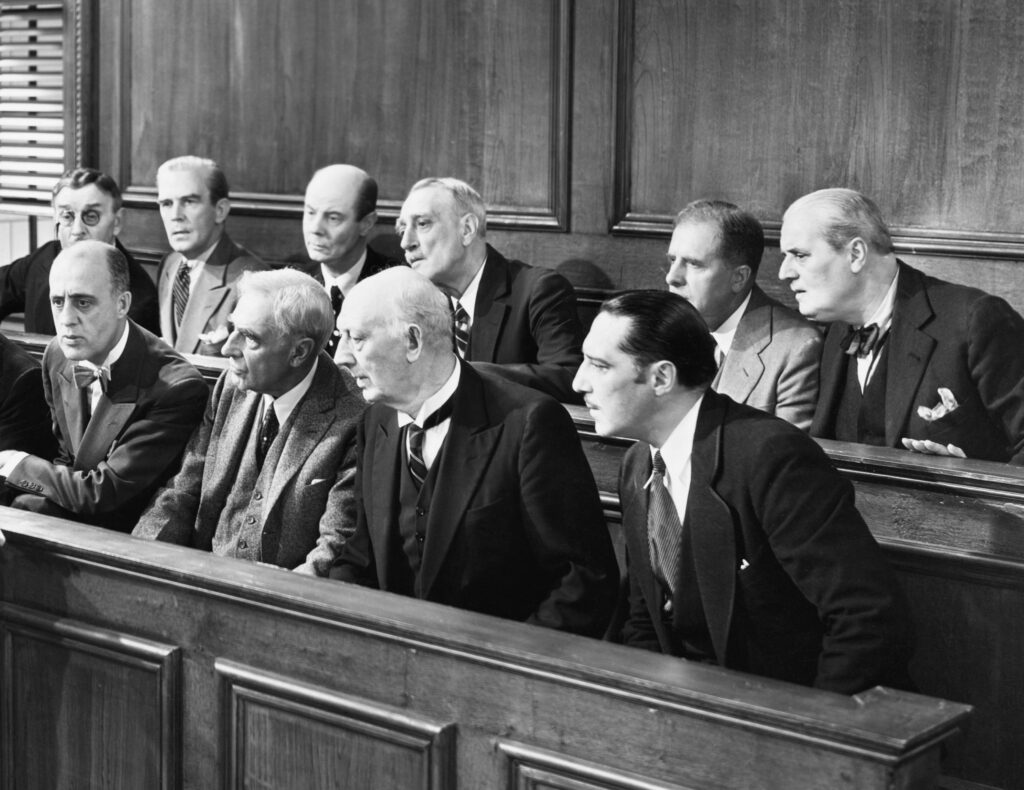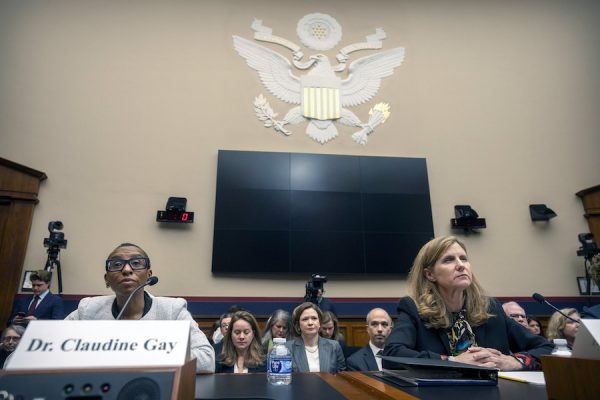One after another, black jurors were removed from the jury pool by District Attorney Doug Evans. On trial was Curtis Flowers, a black man accused in 1996 of committing four murders at the Tardy Furniture shop in Winona, Mississippi, population 5,043, where he was a one-time employee. The evidence against him was weak; the prosecution’s case relied heavily on two witnesses who allegedly heard Flowers confess in jail. One of those witnesses had three prior convictions for forging testimony, and since the first trial, both witnesses have signed sworn statements recanting their testimonies.
Of the forty-four strikes available to Evans, thirty-six were used to dismiss black jurors.
Although the judge had approved the jurors for the trial, Evans subjected black jurors to intense scrutiny, with dozens of questions white jurors did not face. Somewhere in their answers about jobs, friends, capital punishment, and so on, Evans found “race-neutral” reasons, as the court required, to dismiss them. Of the forty-four strikes available to Evans over the course of a series of trials, thirty-six were used to dismiss black jurors. First convicted and sentenced to death in 1997, Flowers has been tried six times by Evans. The first verdict and two subsequent ones were overturned for prosecutorial misconduct, while two other prosecutions ended in hung juries. Despite being penalized for his discriminatory actions against black jurors, Evans seemed doggedly determined to keep Flowers behind bars and to prevent black people from serving on the jury in order to achieve that end. Montgomery county (population 10,023) is 45 percent black, but in 2010, a jury composed of eleven white jurors and one black juror, in a sixth trial, convicted Flowers for quadruple murder for which he was sentenced to death.
As Flowers waited on death row, the journalism podcast In The Dark took up the story, another notable example of how true-crime podcasts are now the leaders of the fourth estate of the justice system, holding it to account and exposing corruption. The host, Madeleine Baran, alongside the other journalists on the team, documented Evans’s misdeeds and interviewed witnesses. Her team’s research in many ways prompted the Supreme Court to hear the case. During oral arguments last March, the justices were incredulous at the apparent discrimination practiced by Evans, especially at the disparate number of questions he asked of black jurors in contrast to white ones. In June they ruled in favor of Flowers and rebuked the actions of Evans. Now, Mississippi–and in particular Doug Evans–will decide whether Flowers will be tried again.
Although the decision, authored by Justice Brett Kavanaugh, is celebrated as a victory for liberals in the context of a conservative court, there are more far-reaching and more actionable issues raised by the Flowers case. The decision is not radical; in fact, it is consistent with the Court’s demonstrated willingness, since Reconstruction, to tackle blatant challenges to the perceived legitimacy of the jury system caused by transparent efforts to exclude of black jurors. But it is not enough to receive an occasional Supreme Court verdict in a few cases of the most outrageous perversions of justice. Instead, the system of allowing peremptory strikes against jurors should be ended altogether, and we should radically change the way that jury lists are constructed.
• • •
The decision in Flowers v. Mississippi relied on a precedent set in Batson v. Kentucky (1986). In that case, the Supreme Court ruled that dismissing jurors on the basis of race is unacceptable, and provided a procedure for redress. When potential jurors are questioned by the judge and the attorneys during voir dire, they are dismissed for cause if the judge deems them unable to perform their duties because of their knowledge of the case, past experiences, or preexisting biases. After these potential jurors are excused, both the prosecution and defense have a fixed number of peremptory strikes that can be used on any remaining juror. Exercising the peremptory strike results in the dismissal of a potential juror without the attorney having to state a reason. If the dismissal is challenged by the opposing side, a reason must be given explaining the removal of the juror and it must not be on the basis of race, ethnicity, or sex. If an attorney cannot offer a neutral reason, the judge will declare the dismissal improper, and the judge will begin the jury selection process again. Yet Batson challenges are notoriously difficult to win because judges are inclined to believe the explanations that attorneys offer.
Originally, it was jurors’ partiality and knowledge of their neighbors that was valuable, not their ability to separate themselves from these instincts.
Within anglophone law, the concept of a trial by a “jury of one’s peers” originated with the Magna Carta in 1215 as a new right of barons to be tried by fellow barons, rather than by the king or his proxies. Then as now, the law fortified the jury to serve as a counterweight to the power wielded by the state and the officers of the law who enforce it. The jury prevents—or should prevent—the trial from being a rigged game. In medieval England, where the jury emerged as a fixture of the institution of the trial, its legal value was located in the jurors’ particular knowledge of the people and facts relevant to the case. Jurors were, in a manner of speaking, experts in the society in which the crime had taken place. It was precisely their partiality and knowledge of the reputations of their neighbors that was valuable, not their ability to separate themselves from these instincts. Such expertise in jurors was so esteemed in medieval English courts that when the defendant was a foreigner or from a particular guild, such as the merchants, it was necessary to find jurors with similar backgrounds.
As the adversarial trial evolved and the role of attorney, jurors, and witnesses became further differentiated, jurors were not expected to have the same relationship to the defendant. In fact, they were ultimately supposed to have no relationship at all. Yet assessing the credibility of witnesses and of the defendant continues to depend on an understanding of the lifeworld of the defendant, the community and employment possibilities open to them, the slippages between the protection and the threat of law enforcement in their neighborhoods, and, most importantly, what guilt and its opposite might look or sound like. Determining guilt requires an understanding of the context of the alleged crime: it is not merely a factual exercise, and jurors must navigate between judgments based on prejudice and those based on considered reflection. Furthermore, whether or not one trusts a witness is likely to depend not only on errors of fact or outright deception, but on verbal and nonverbal cues, as well as the affective response that a juror has to the witness. This understanding and familiarity is what Flowers needed from a jury of his peers.
The prevalence of racial discrimination in our history means that attorneys should not have the privilege to act on hunches.
In his 1986 concurrence in Batson, Justice Thurgood Marshall, in prescient fashion, outlined the possibility of getting rid of peremptory strikes altogether. He saw the dangers inherent to asking judges to decide whether or not lawyers are acting in good faith. In response to the concern that prosecutors would likely lie about the reasons they are dismissing jurors in order to avoid a violation, he wrote:
Nor is outright prevarication by prosecutors the only danger here. ‘It is even possible that an attorney may lie to himself in an effort to convince himself that his motives are legal.’ A prosecutor’s own conscious or unconscious racism may lead him easily to the conclusion that a prospective black juror is ‘sullen,’ or ‘distant,’ a characterization that would not have come to his mind if a white juror had acted identically. A judge’s own conscious or unconscious racism may lead him to accept such an explanation as well supported.
In effect, Marshall declares ineffectual any corrective measure for racial discrimination during voir dire that is based upon trusting the officer of the law to separate out good reasons from racially dubious ones. There must be another way to save attorneys and judges from themselves at this most critical step in the jury process. The prevalence of racial discrimination throughout our history means that attorneys should not have the privilege to act “on hunches” during voir dire and eliminate jurors for nebulous reasons. Taken to its conclusion, removing the peremptory strike is a return to the ideal of selection by lot as the basis for a fair and representative jury. If jurors are only to be dismissed by the judge for cause, the default orientation becomes the acceptance of all potential jurors.
One may argue that removing peremptory strikes, a longstanding aspect of the trial process, unduly constrains the discretion of attorneys. Defense attorneys, too, value having the chance to remove potential wild-card jurors who may be difficult to persuade. One can arguably target racial discrimination in jury selection in less dramatic ways, such as when judges insist that the same questions are asked of all jurors and thereby make it hard for attorneys to make questionable claims about why black jurors have been excused. Yet this solution returns us to the problem identified by Justice Marshall: the unconscious motivations of attorneys and judges. A jury of one’s peers is explicitly not a jury of legal experts and there is an inherent tension in such experts being its gatekeepers. Lawyers may resist truly empowering jurors—especially jurors who share a community and context with the defendant—because through that empowerment lawyers lose a measure of control over the outcome.
Assessing the credibility of witnesses and of the defendant depends on an understanding of the lifeworld of the defendant.
A second reform to achieve the ideal of a jury of one’s peers would be to amend the process used to create the venire, the list from which names are randomly selected for jury duty. Most states draw the names of potential jurors from driver’s license lists and voter registries, both of which privilege more affluent citizens and those who have stable addresses from year to year. The example of Massachusetts, the only state in the country to use annual municipal census data to create the venire, is instructive. This means that potential jurors are chosen via residency lists, updated yearly, which is more effective at generating a venire whose racial, gender, and socioeconomic status parallels the population at large. The Court has said that a “fair cross-section” of the population should be represented in the venire and changing the process would facilitate this in concrete ways.
The Flowers case is an American tragedy—the forces of racism, the legacy of the Jim Crow South, and the false promise of procedural justice all came together to result in him spending the last twenty-three years in prison. All advantages of wealth, power, and privilege were stacked against Flowers, but his trials by jury were supposed to act as the check against these. Nonetheless Evans’s manipulation of the jury system prevented even that. Although only a tiny fraction of criminal trials are heard before a jury, the jury system is the key to the integrity of criminal justice. Even the most conservative Supreme Court justices agree on this. A return to the original intent of the jury as composed of peers would be a groundbreaking step in giving power over legal outcomes to the people who are in the best position to judge. For African Americans, who have been persistently denied fair trials through conscious and unconscious racism, this would be a valuable first step in providing control over legal outcomes.








